
 Wine myths…
Wine myths…
I recently wrote an article about a myth on wine that has been very difficult to kill. It struck me that it could be a good theme for a series of articles. There are too many myths around wine.
What I wrote about (and you can read more about below) was irrigation. No, it is not forbidden to irrigate in the vineyard. But that’s just one example. Here are some more ideas about what the article series about myths on wine could contain:
“If are an organic wine producer, you are not allowed to spray with pesticides in the vineyard” – wrong, organic producers also spray the vines with pesticides.
And to continue on the “eco” theme:
“An organic wine tastes different” – no, organics has mainly to do with the environment. You cannot taste a wine and determine if it is organic.
Chenin blanc tastes like wet wool – now, one should perhaps not criticize taste descriptions. That’s very personal. But there are few things that sound, to my ear, as unpleasant as wet wool. And chenin blanc is one of the world’s finest and greatest white wine grapes. Read more about chenin blanc in Brief!
“If you want to age wine it is important to have an even and cool temperature” – well, maybe to a certain extent, but wine is much more sturdy than one often thinks.
“An opened bottle of wine goes bad in a few days” – no, put a cork in a half-finished wine bottle it will keep for many days in the fridge.
Just a few examples!
Do you have any more suggestions? Which myths should write about? Send us an email!
Right now it is our most hectic travel season, so there is not much time to write (or send newsletters). The Loire Valley, Valpolicella, Bordeaux, Champagne, Rioja… are just some of the wine regions where we have put our feet down this wine travel season. Read more about upcoming wine tours below.
Britt & Per
PS: Recommend to your friends to read the Brief !
– – – – – –
What’s on at BKWine Tours
Winter 2018
- Chile and Argentina, January 27 – February 11, 2018
- South Africa, February 23 – March 5, 2018 (with possible safari and golf add-on)
Spring 2018
- Bordeaux, 25-29 April
Autumn 2018
More to come:
- Bordeaux, September 26-30
- South Africa, November
Winter 2019
- New Zealand, March
For more information please contact us on email or on phone (we’re on French time), or go to our wine travel site on www.bkwinetours.com!
We also make custom designed wine tours – on-demand tours for you and a group of friends, for your company (maybe to scout new winegrowers?), for a special event… We can combine winery visits and wine touring with other activities: gastronomic workshops, visit to an oyster farm, truffles hunting, cheese making, and more. More info on the custom designed and bespoke BKWine wine tours and travel here!
Read our book(s)
We have written several wine books, nine at the last count. One of them has been translated to English; the others are (so far) only available in Swedish. This is the one that is available in English: Biodynamic, Organic and Natural Winemaking, Sustainable Viticulture and Viniculture
All our books are on wine, but on different subjects: wines of the Languedoc, wine growing and wine making, the wines of France, Tuscany, Bordeaux, Piedmont, Burgundy, Champagne. Several have won prestigeous prizes and awards. Read more on our wine books.
From the World of Wine
In Brief
In short, news and stuff from the world of wine.
Swedish winery gets a medal at the AWC Vienna
 Sweden is definitely a cool climate wine country. We have a few brave wine producers, most of them very small and most of them in the southernmost part of Sweden. Fredholms Wine Estate in Tyringe in Skåne is one and recently this estate received a medal, a “seal of approval” in AWC Vienna for its white wine Collina Memoria. Congratulations! AWC Vienna is one of the world’s biggest wine competitions. In 2017 12,600 wines from 40 countries were tasted and judged by qualified jurors.
Sweden is definitely a cool climate wine country. We have a few brave wine producers, most of them very small and most of them in the southernmost part of Sweden. Fredholms Wine Estate in Tyringe in Skåne is one and recently this estate received a medal, a “seal of approval” in AWC Vienna for its white wine Collina Memoria. Congratulations! AWC Vienna is one of the world’s biggest wine competitions. In 2017 12,600 wines from 40 countries were tasted and judged by qualified jurors.
Pär and Jenny have around 850 vines. They released their first commercial wine in the summer of 2013. This summer they launched Collina Memoria and a rosé named Amici came. The grapes are Rondo, Siramé and Solaris. All three are grapes with good resistance to fungal diseases. A big advantage in this cool and humide climate. Read more: www.fredholmsvin.se.
A crazy idea? Selling wine at the cellar door?
This may sound absurd but it is true. The wine producers are not allowed to sell their wines at the cellar door. It is strictly forbidden. This is not in any normal wine country but in Sweden. There are actually a few vineyards in Sweden, perhaps 20, maybe even more, but with of course very small acreages. Since there is a retail monopoly in Sweden these producers are not allowed to sell their wines to visitors. They can hope to be selected by the monopoly (not always easy) or they can export their wines to other countries. Or try and get their wines listed on the obscure “on order” range.
There is a currently a political debate if cellar door sales should be permitted (“gårdsförsäljning”). More and more politicians support it. But the Systembolaget monopoly does not like this. They have bought full-page propaganda ads (costing millions) in virtually all Swedish papers and sent letters to all politicians. One would have thought that the monopoly should execute the will of the people and the politicians but the Systembolaget is apparently of a different opinion. They think it is Systembolaget who should tell the people and the politicians what to think. Odd, isn’t it?
A few comments in Swedish press (use Google Translate if you are curious):
- Systembolagets vd:s varning till politikerna.
- Gå hem, du är för full, Systembolaget
- Dags att avskaffa Systembolaget
Protect the must with yeast instead of sulphur
Natural wines are fashionable at the moment and there is a lot of talk about the difficulty of making wine without adding sulphur. But what if it’s not that hard? Since a few years’ back there is something called bio protection. It means that by adding special yeasts for the fermentation the wine makers can protect their must and their wines from oxidation and off flavours. Without using sulphur.
The yeast varieties to be added are other than the usual Saccharomyces. These non-Saccaromyces yeast varieties are found in wild fermentation, usually in the beginning, before Saccharomyces cerivisae takes over and finishes the fermentation. And now they are available also as cultured yeast. In France, there are around 20 different non-Saccharomyces yeast varieties available on the market. The most common is Torulaspora delbrueckii. This yeast type reduces, among other things, the risk of the development of volatile acidity. So maybe this is the future for those producers who don’t want to add sulphur. Interesting.
Chinese wines from Ningxia
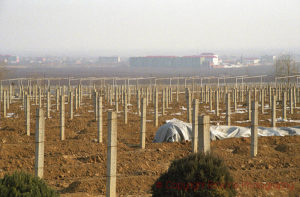 I (Britt) visited Ningxia, one of China’s new wine regions, at the end of August. Ningxia is about a two hours’ flight west of Beijing, on the border to the Gobi Desert and Mongolia. There are now around 40,000 hectares, mostly planted in the last 10 years. Ambitions are high. Already they are starting to create a classification of the wine estates, inspired by the Bordeaux classification 1855.
I (Britt) visited Ningxia, one of China’s new wine regions, at the end of August. Ningxia is about a two hours’ flight west of Beijing, on the border to the Gobi Desert and Mongolia. There are now around 40,000 hectares, mostly planted in the last 10 years. Ambitions are high. Already they are starting to create a classification of the wine estates, inspired by the Bordeaux classification 1855.
The climate is dry and extremely continental. The summers are hot and the winters are really cold, so cold that the vines must be totally covered with soil to survive. A procedure, according to Frenchman Thierry Courtade at the Silver Heights vineyard, probably means that the vines will not live longer than around 20 years. Perhaps a problem for a wine region that has Bordeaux as its role model. On the other hand, some research shows that the age of the vines is not that important. You will hear more about the Ningxia wines on BKWine Magazine.
On travelling in Burgundy, what customers say
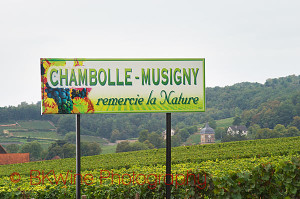 We have published some more comments on our travel blog on what customers, travellers, have had to say about our wine tour to Burgundy. On our tours in Burgundy we show both sides of the wine industry, both the big negociants, which are an important part of the wine sector, not least internationally, but the focus is mostly on the smaller producers. It is easy to just go for the most fames names in this region, but not always the most interesting. If you are not intimately familiar with Burgundy, finding the most interesting wine estates to visit can be difficult. Read what our travellers have to say: Happy customers comment on a wine tour in Burgundy.
We have published some more comments on our travel blog on what customers, travellers, have had to say about our wine tour to Burgundy. On our tours in Burgundy we show both sides of the wine industry, both the big negociants, which are an important part of the wine sector, not least internationally, but the focus is mostly on the smaller producers. It is easy to just go for the most fames names in this region, but not always the most interesting. If you are not intimately familiar with Burgundy, finding the most interesting wine estates to visit can be difficult. Read what our travellers have to say: Happy customers comment on a wine tour in Burgundy.
Ningxia Winemakers Challenge
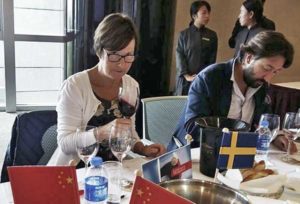 Ningxia started an original project in 2015, the Ningxia Winemakers Challenge (NWC). 48 different wine makers from all over the world were invited to Ningxia for the harvest that year. Each winemaker was paired with a local winery and received three hectares of vines each to dispose of. That year, 2015, the 48 winemakers made a wine together with their partner winery. During the two years that have elapsed since, they have returned to Ningxia and checked their wine a couple of times. At the end of August this year, a jury tasted and judged the 48 wines and medals were awarded. And among the winners of the gold medals there was actually a Swedish wine maker, Slavina Stefanova.
Ningxia started an original project in 2015, the Ningxia Winemakers Challenge (NWC). 48 different wine makers from all over the world were invited to Ningxia for the harvest that year. Each winemaker was paired with a local winery and received three hectares of vines each to dispose of. That year, 2015, the 48 winemakers made a wine together with their partner winery. During the two years that have elapsed since, they have returned to Ningxia and checked their wine a couple of times. At the end of August this year, a jury tasted and judged the 48 wines and medals were awarded. And among the winners of the gold medals there was actually a Swedish wine maker, Slavina Stefanova.
I asked Svetlana what she really thinks about Ningxia’s potential as wine region: ” Despite the many challenges – severe continental climate and poor viticultural standards being only two of them – the feeling I have is that the future of Ningxia as a fine wine producer is a foregone conclusion, a question of when, not if.”
Buy chenin blanc to drink or to age
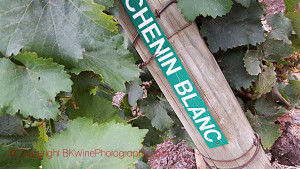 We were recently doing wine tour with wine lovers in the Loire Valley we tasted some really delicious chenin blanc wines, many of them. Chenin blanc has never really caught on as a trendy grape, not at all like riesling, with which it shares several characteristics. We have never understood why since it is a grape that gives fantastic wines. It is not very common but when you have it in the glass it is often easy to recognise. It has notes of honey, bee wax, apricots, citrus. It can be bone dry or lusciously sweet. And the wines can age magnificently. We had the great pleasure to taste one from the 50s on the tour. Here are two suggestions for wines to try that are widely distributed:
We were recently doing wine tour with wine lovers in the Loire Valley we tasted some really delicious chenin blanc wines, many of them. Chenin blanc has never really caught on as a trendy grape, not at all like riesling, with which it shares several characteristics. We have never understood why since it is a grape that gives fantastic wines. It is not very common but when you have it in the glass it is often easy to recognise. It has notes of honey, bee wax, apricots, citrus. It can be bone dry or lusciously sweet. And the wines can age magnificently. We had the great pleasure to taste one from the 50s on the tour. Here are two suggestions for wines to try that are widely distributed:
- Clos de Saint Yves, Domaine des Baumard, Savennières (~19 euro). A favourite from the Loire and a steal at that price.
- Langlois Chateau, Saumur Vieilles Vignes (~20 euro). Full-bodies and complex.
- Mullineux, Swartland Old Vines, South Africa (~19 euro). If you can find it. One of the big stars in South Africa. 74% chenin blanc.
Features
Features that we have published during the past month, with lots of reading for you.
A producer in the southern Rhone Valley to keep an eye on: Domaine de Marcoux
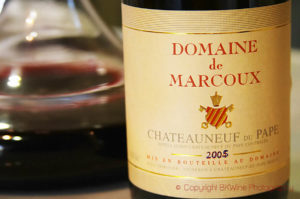 Domaine de Marcoux is a family property in the northern part of Châteauneuf-du-Pape. In addition to the exclusive chateauneuf wine, they also make côtes du rhône and vin de france, all of very good quality. On September 14, a triplet of Marcoux wines is launched on the Swedish market by Caviste, but the wines are of course also available on other markets.
Domaine de Marcoux is a family property in the northern part of Châteauneuf-du-Pape. In addition to the exclusive chateauneuf wine, they also make côtes du rhône and vin de france, all of very good quality. On September 14, a triplet of Marcoux wines is launched on the Swedish market by Caviste, but the wines are of course also available on other markets.
BKWine Magazine’s reporter Tobias Karlsson has tasted them: Delicious triplet of Rhône wines from Domaine de Marcoux.
Talking to Bruwer Raats, chenin blanc and cabernet franc specialist in South Africa
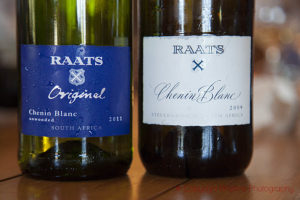 “Considered the driving force behind South Africa’s recognition for producing world-class chenin blanc, the burly South African wine maker Bruwer Raats specialize in high quality chenin blanc and cabernet franc sourced from a variety of South Africa’s wine regions and microclimates. Each wine expressive of it’s unique terroir, or ‘sense of place.’ Raats also enjoys a partnership with Zulu winemaker Mzokhona Mvemve in Mvemve Raats, on an award-winning wine project called de Compostella (‘Composed of the Stars’) voted Best Red Blend in 2004 by Wine Spectator.”
“Considered the driving force behind South Africa’s recognition for producing world-class chenin blanc, the burly South African wine maker Bruwer Raats specialize in high quality chenin blanc and cabernet franc sourced from a variety of South Africa’s wine regions and microclimates. Each wine expressive of it’s unique terroir, or ‘sense of place.’ Raats also enjoys a partnership with Zulu winemaker Mzokhona Mvemve in Mvemve Raats, on an award-winning wine project called de Compostella (‘Composed of the Stars’) voted Best Red Blend in 2004 by Wine Spectator.”
Read more in LM Archer’s article on BKWine Magazine: Talking with Bruwer Raats, winemaker in South Africa.
Do join us on a tour to South Africa and we will show you some of the best wines and wineries in the country, on the wine tour to South Africa.
South Africa’s magnificent sparkling wine, Methode Cap Classique, as interpreted by Graham Beck
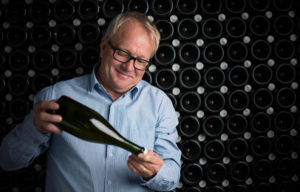 If Champagne has a sibling, it may be méthode cap classique. Specific to South Africa, cap classique employs the same “traditional method” used to make champagne, whereby the second fermentation occurs in bottle. And if South Africa’s méthode cap classique sparkling wine has a ‘godfather’, it’s Pieter “Bubbles” Ferreira, cellarmaster at Graham Beck Wines in Robertson.
If Champagne has a sibling, it may be méthode cap classique. Specific to South Africa, cap classique employs the same “traditional method” used to make champagne, whereby the second fermentation occurs in bottle. And if South Africa’s méthode cap classique sparkling wine has a ‘godfather’, it’s Pieter “Bubbles” Ferreira, cellarmaster at Graham Beck Wines in Robertson.
BKWine Magazine’s contributor LM Archer meets one of the pioneers of South African sparkling wine, also know under the shorter denomination MCC: A bubbly ride in South Africa – meet Pieter Ferreira at Graham Beck.
Here are some tasting notes on the wines: Tasting two Graham Beck sparkling wines from South Africa.
Do join us on a tour to South Africa and we will show you some of the best wines and wineries in the country, on the wine tour to South Africa.
Irrigation in the vineyards, surely that is not allowed?
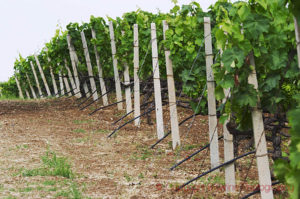 Yes it is. Truth: Irrigation is allowed, but it is strictly regulated. It’s a persistent myth that it’s forbidden to irrigate in the vineyards in Europe. In the past, the rules were stricter, it was even sometimes forbidden, even though it was always allowed to a certain extent. But today it is allowed, but strictly regulated. By irrigating you can increase production. The vine sucks up the water and the grapes grow bigger and you get more wine, but of lower quality. That is why there are restrictions and why in the past it was “forbidden”.
Yes it is. Truth: Irrigation is allowed, but it is strictly regulated. It’s a persistent myth that it’s forbidden to irrigate in the vineyards in Europe. In the past, the rules were stricter, it was even sometimes forbidden, even though it was always allowed to a certain extent. But today it is allowed, but strictly regulated. By irrigating you can increase production. The vine sucks up the water and the grapes grow bigger and you get more wine, but of lower quality. That is why there are restrictions and why in the past it was “forbidden”.
Read more on irrigation in Per’s article on BKWine Magazine: Myths about wine: “It is forbidden to irrigate in the vineyard”.
Wine tours
Some information about current and future wine tours with BKWine.
Some of next year’s wine tours open for booking
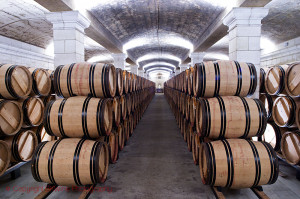 We have not yet planned all the wine tours on the schedule for next year but you can already book some of them. This is what we have published so far (more will come):
We have not yet planned all the wine tours on the schedule for next year but you can already book some of them. This is what we have published so far (more will come):
Chile & Argentina, January 27 – February 11. Sorry, this is fully booked but will return in Jan-Feb 2019.
South Africa, February 23 – March 5. Only very few places remaining. Book now. And don’t miss the magnificent safari that we offer as an add-on.
Bordeaux, April 25-29 and Bordeaux, September 26-30. The wine tour to Bordeaux is an all-time classic. We take you to places where others don’t go. To see the real wine scene of Bordeaux. More autumn wine tours will come soon.
The South Africa wine tour comes back in November 2018. We will soon publish full details.
We are also planning a wine tour to New Zealand in March 2019. It promises to be exceptional. Something to put on your long-term planning!
South Africa, wine and food in combination | a world class wine tour
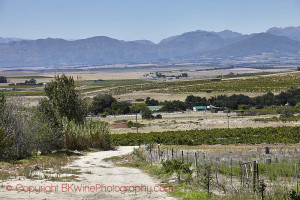 South Africa has about 100,000 hectares (240,000 acres) of vineyards. This figure has been stable for a long time. What has changed is how the grapes are used. During apartheid, over 50% of the grapes went to distillation for brandy production. Now most grapes are used to make wine.
South Africa has about 100,000 hectares (240,000 acres) of vineyards. This figure has been stable for a long time. What has changed is how the grapes are used. During apartheid, over 50% of the grapes went to distillation for brandy production. Now most grapes are used to make wine.
During our tour in the South African wine regions, we will see many examples of this change. More and more producers are making interesting and exciting wines. There is an incredible variety of grape varieties planted in South Africa today. The variety of wine styles is huge. Which is good. And the quality level is astonishing. The South African gastronomy is also very rich in different styles. And delicious. Among other things, we will get to know the traditional and spicy Cape Malay cuisine. With homemade samoosa and bobotie on the plate and a Pinotage in the glass we will not have much to complain about.
Read more on the wine tour to South Africa on 23 February to 5 March 2018, and then again in November 2018.
You can extend your holiday, with our “add-ons”: after the wine tour with safari and before the wine tour with golf.
You can see plenty of pictures and videos from the tour on the Facebook group for the wine tour to South Africa 2017.
Don’t be an egoist! Share with your friends and other wine enthusiasts! Forward the Brief to your friends! Suggest that they sign up for a free subscription !
© Copyright BKWine







